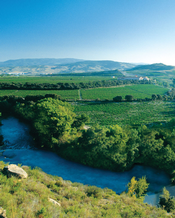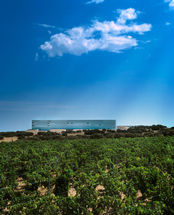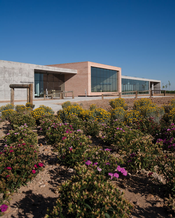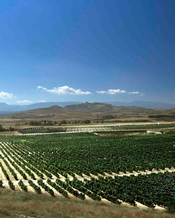|
|
 |
.jpg)
Joaquín Martínez Bujanda started a winery in Oyón in the Rioja region of Spain in 1889. His modest concept was to make wines from grapes he grew himself. In the early 1950s, the next generation created Cosecheros y Criadore, dedicated to making wines from their vines for export. Carlos and Pilar Martinez Bujanda--of the fourth generation--are responsible for the addition of four unique estates, two in Rioja, one in Rueda and one in La Mancha. Thus was born Familia Martinez Bujanda.
I met recently with a fifth-generation family member, Marta Martinez Bujanda, who is responsible for exports. She showed me a few of her family’s wines and told me about their four estates. I was impressed by the quality of the wines, even more so when I learned what strong values they represent when prices are taken into account. The wines I tasted were strikingly similar in their seamless integration. Nothing stuck out. They reflect the values of a 128-year-old vision.
Siblings Carlos and Pilar’s first project, established in 1999, was Finca Valpeidra. It is a single vineyard estate and a member of the Grandes Pagos de España, a non-profit organization that was established to  “highlight the unique personality of wines made from the best vineyards and to promote the culture of single vineyard estates.” Think of a pago like a climat in Burgundy or a cru in Bordeaux. Members of this organization may or may not have wines labeled with the Vino de Pago DO, a new appellation established in 2003. While Finca Valpeidra certainly meets the qualifications of the Vino de Pago DO, the Rioja appellation is a Denominación de Origen Calificada (DOCa), and neither Rioja or Priorat recognizes the Vino de Pago DO. According to Wines of Spain, should either decide to approve this single vineyard appellation it will be labeled Vino de Pago Calificado. “highlight the unique personality of wines made from the best vineyards and to promote the culture of single vineyard estates.” Think of a pago like a climat in Burgundy or a cru in Bordeaux. Members of this organization may or may not have wines labeled with the Vino de Pago DO, a new appellation established in 2003. While Finca Valpeidra certainly meets the qualifications of the Vino de Pago DO, the Rioja appellation is a Denominación de Origen Calificada (DOCa), and neither Rioja or Priorat recognizes the Vino de Pago DO. According to Wines of Spain, should either decide to approve this single vineyard appellation it will be labeled Vino de Pago Calificado.
Finca Valpeidra is located in Rioja Alta, in a gorgeous setting in the elbow of the Ebro River. The name Valpeidra, or “stone valley,” refers to the stone-covered soil, which soaks in heat from the sun in the day then radiates it at night, ensuring ripening of the grapes. In fact, the vines here are ready for harvest two weeks earlier than other vineyards in the area, timing that allows them to avoid autumn rain. Grapes are hand harvested, so selection of the best bunches begins in the vineyard with additional selection at the winery. The attention to grape quality and knowledgeable handling in the winery is evident in the wines.
The Cantos de Valpiedra, Rioja DOCa, Crianza 2013 ($19, imported by Winebow) is pure Tempranillo aged 12 to 14 months in French and American oak, then 18 months in bottle before it is released. Its savory strawberry and cherry fruit is layered with aromatic herbal notes, balanced by lively acidity and structured with ripe tannins. The Valpiedra Reserva 2009 ($45) is a very elegant and stylish wine, vibrant with dark cherry fruit showing cedar-box aromas of bottle age. It is graceful on the tongue with velvet tannins. It is mostly Tempranillo with a touch of Graciano and Maturana Tinta aged 20-24 months in French oak.
Finca Antigua estate became part of the family in 1999 with completion of the winery in 2003. It is in La Mancha, which is not only Spain’s largest  wine appellation, or Denominación de Origen (DO), but the largest in Europe. As befitting the largest DO, the estate is almost 2,500 acres with 1,040 acres of vineyards, many of which were original to the property. Their annual production is I million bottles or 83,000 plus 12-bottle cases. The property is at almost 3000 feet, which makes it the coolest area in the warm region of La Mancha. Temperatures vary greatly from the hot days to ripen grapes to cool nights that preserve the natural acidity. These conditions can provide wines that are fresh and lively. wine appellation, or Denominación de Origen (DO), but the largest in Europe. As befitting the largest DO, the estate is almost 2,500 acres with 1,040 acres of vineyards, many of which were original to the property. Their annual production is I million bottles or 83,000 plus 12-bottle cases. The property is at almost 3000 feet, which makes it the coolest area in the warm region of La Mancha. Temperatures vary greatly from the hot days to ripen grapes to cool nights that preserve the natural acidity. These conditions can provide wines that are fresh and lively.
One of the reasons the family chose this area for their new winery was to be able to plant grape varieties not allowed in Rioja, such as Merlot, Cabernet Sauvignon, Petit Verdot and Syrah as well as traditional varieties like Viura, Garnacha, Tempranillo and Mocatel. The vines are planted in single variety plots that are harvested and processed separately in the winery. The grapes are harvested at night to take advantage of the cooler temperatures.
I got to taste examples of wines from both a traditional and “international” variety. The aromas of the Finca Antigua, La Mancha DO, Single Estate, El Palomar, Sobre Lías Viura 2016 ($14) initially were quite subdued, but after I went back to it during the tasting, it had opened and was delightfully fragrant with apples and pink grapefruit with floral notes. It was an ethereal wine, delicate, yet round and creamy due to five or so months on the lees. Marta said that their Viura ages better than their Verdejo. The 2013 Crianza Cabernet Sauvignon ($12) from the Las Mateas vineyard, had spicy cherry, coconut aromas and flavors with hints of fresh herbs, perhaps those growing wild around the vineyard. In the mouth the wine was lively and fresh with ripe tannins. It spends 10 months American oak.
Finca Montepedroso (2008) is the highest vineyard in Rueda with 82 acres of Verdejo. Carlos and Pilar could have grown Verdejo at their Valpeidra  estate in Rioja or their Antigua estate in La Mancha, but they decided to go to Rueda where Verdejo reigns. estate in Rioja or their Antigua estate in La Mancha, but they decided to go to Rueda where Verdejo reigns.
I have an avid appreciation of wines from Rueda. Several years ago on my first visit to the region, I stayed in Valladolid. In the evening after visiting wineries, my colleagues (including WRO editor Michael Franz) and I would visit tapas bars for an early meal. Initially, I tried a few reds with the various tapas, but I found quickly that the Ruedas, especially the Verdejos, worked with every dish. They also are reliably inexpensive with very high quality for the price.
Finca Montepedroso, Rueda DO, Verdejo 2016 ($15) is a great example with exuberant floral, green apple aromas with a wisp of fresh herbs. Round and creamy with apple, melon flavors brightened with citrusy acidity. I was amazed with how long the flavors lingered in my mouth.
After creating three estates, I guess it was time to go back to where it all began. In 2009, Viña Bujanda was born in Oyón to create classic Rioja.  Bujanda’s nearly 394 acres of Tempranillo and Viura vineyards are located in Rioja Alta and Rioja Alavesa. The sites offer different soil composition and sun exposure to provide different flavor profiles for complexity in the wines. The Viña Bujanda, Rioja DOCa, Crianza 2014 ($10) is just delicious. It is 100 percent Tempranillo with bright dark cherry flavors and a bit of baking spices from the American oak. It is light bodied and goes down easy. I kept going back to the Viña Bujanda, Rioja DOCa, Gran Reserva 2010 ($28). It just kept evolving in the glass. It had intense aromas of dark fruit with herbal anise notes. In the mouth it was light, smooth with great integration of fruit, acidity, tannins and alcohol. Bujanda’s nearly 394 acres of Tempranillo and Viura vineyards are located in Rioja Alta and Rioja Alavesa. The sites offer different soil composition and sun exposure to provide different flavor profiles for complexity in the wines. The Viña Bujanda, Rioja DOCa, Crianza 2014 ($10) is just delicious. It is 100 percent Tempranillo with bright dark cherry flavors and a bit of baking spices from the American oak. It is light bodied and goes down easy. I kept going back to the Viña Bujanda, Rioja DOCa, Gran Reserva 2010 ($28). It just kept evolving in the glass. It had intense aromas of dark fruit with herbal anise notes. In the mouth it was light, smooth with great integration of fruit, acidity, tannins and alcohol.
The Martinez Bujanda family is making very impressive wines. They convey their mission and philosophy clearly in their wines. Not an easy feat. The fact that they can craft and sell such fine wines at such affordable prices seems like an impossibility, but they do.
|
 |
|